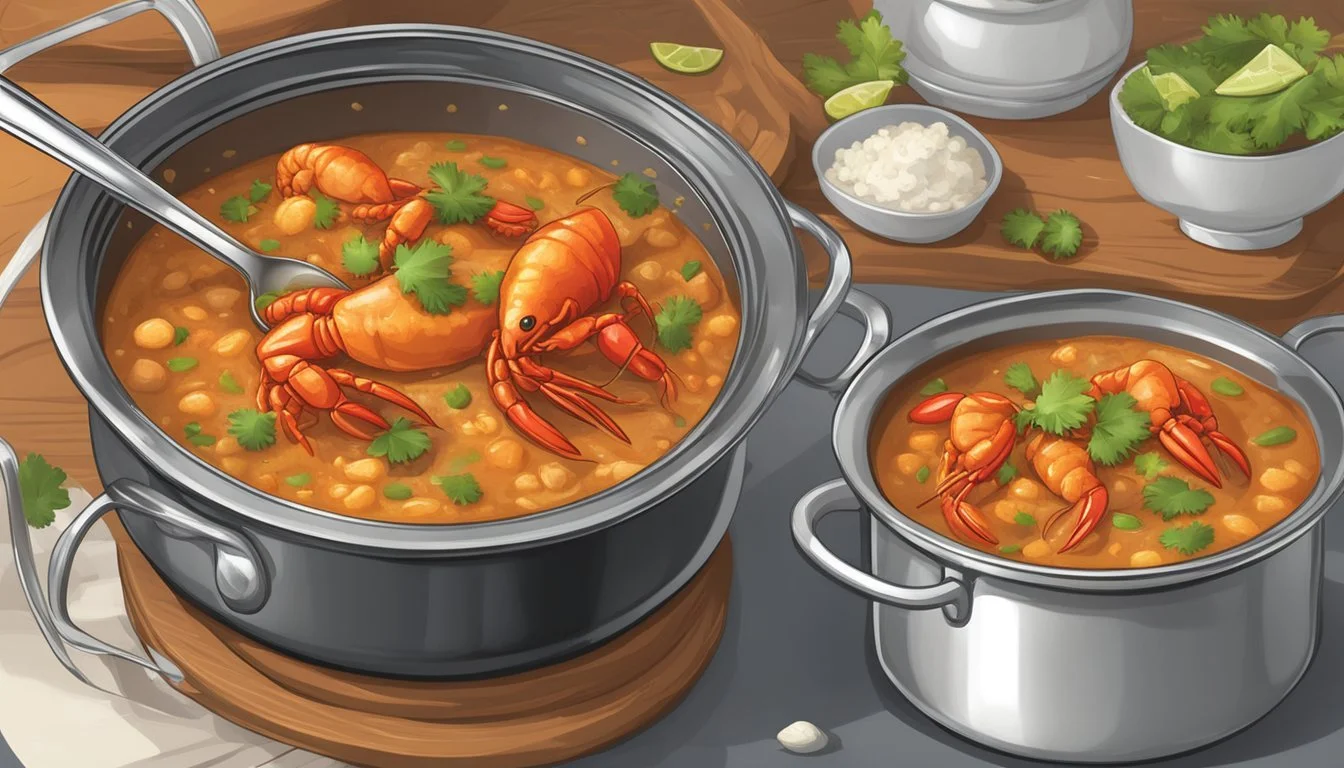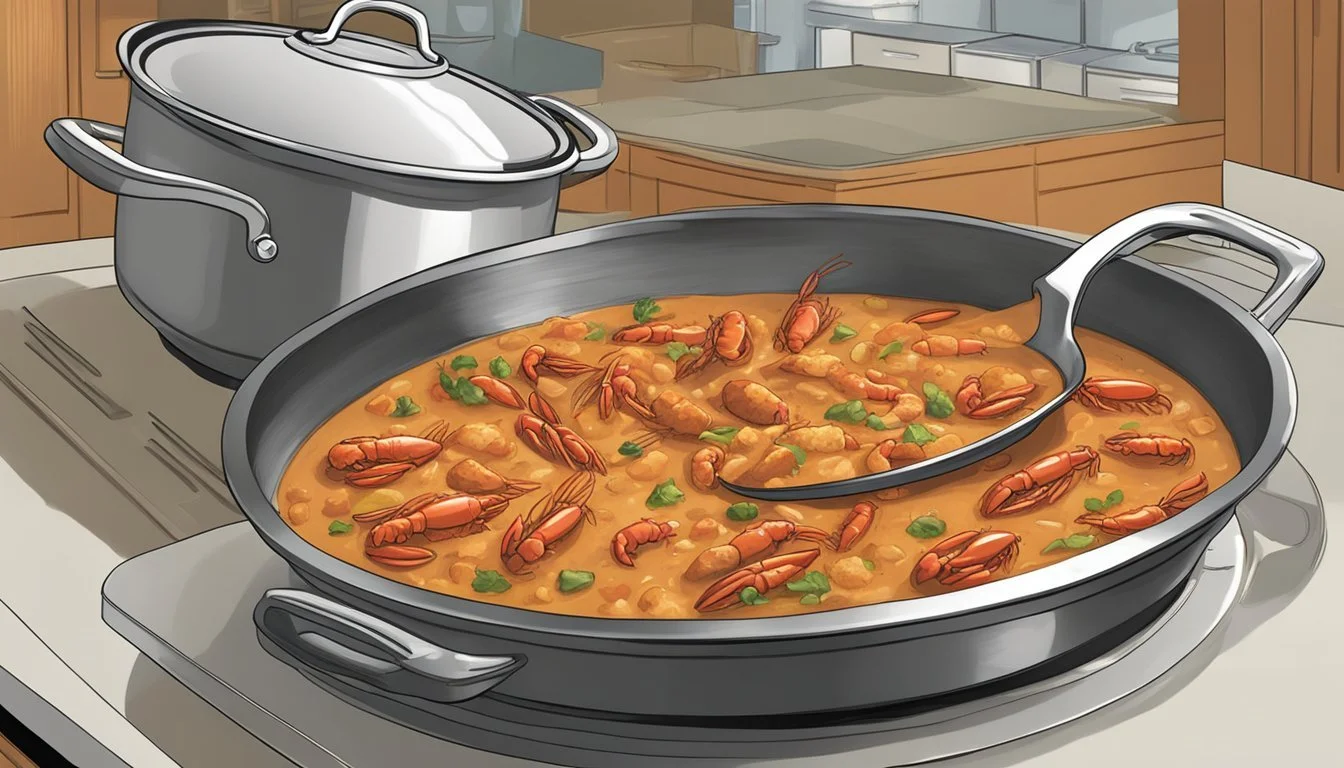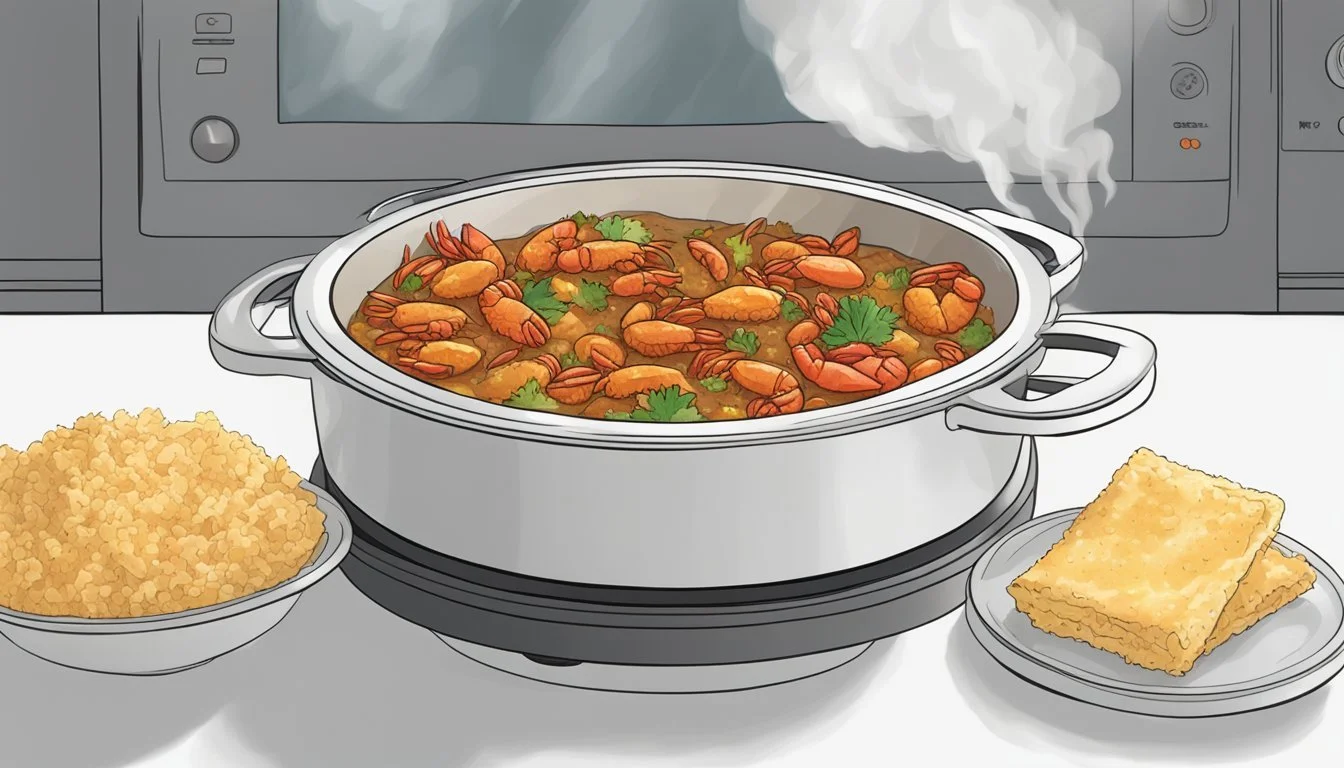Best Way to Reheat Crawfish Étouffée
Ensuring Creaminess and Spiciness Retention
Crawfish Étouffée is a beloved dish in Cajun and Creole cooking, treasured for its rich, creamy sauce and the bold, spicy flavors that enliven the tender seafood within. When it comes to reheating this dish, the challenge lies in maintaining its distinct creaminess and the punch of its spiciness. A careful approach is required to ensure that the texture and flavors are as close to the original as possible, despite the passage of time since the dish was first prepared.
The key is gentle, even reheating that slowly brings the Étouffée back to temperature without sacrificing its delicate sauce consistency and layered spicing. Methods vary, from stovetop simmering to a careful turn in the microwave, but each technique has to be approached with an understanding of the dish’s unique elements. Temperature control, covering, and occasional stirring play pivotal roles in reviving the Crawfish Étouffée to its former glory, ensuring that every spoonful is as satisfying as it was when first served.
Understanding Crawfish Étouffée
Crawfish Étouffée is a classic Creole and Cajun dish, beloved for its creamy and spicy sauce, typically served with rice. Originating from Louisiana, the word "étouffée" (pronounced eh-too-fey) is French for "smothered" or "suffocated," referring to the cooking method in which the crawfish are cooked in a rich gravy.
The key components of a traditional Crawfish Étouffée include:
Crawfish: Fresh is ideal, but the dish is also an excellent way to use leftover crawfish.
Roux: A mixture of flour and fat, it's the base for the sauce that thickens and adds a depth of flavor.
Holy Trinity: This is a combination of onion, celery, and bell pepper, which are sautéed and form the aromatic foundation of the dish.
Stock: Typically chicken or seafood stock is used to create the desired consistency of the sauce.
Seasonings: Cajun or Creole spices, including garlic, are used to enhance the flavor profile of the étouffée.
When reheating Crawfish Étouffée, maintaining its inherent creaminess and spiciness is paramount. The consistency of the gravy, combined with the tender texture of the crawfish, brings about the heartiness and warming spice that the dish is known for. It is essential to reheat carefully to preserve these qualities, especially when dealing with leftovers. Such attention ensures the Crawfish Étouffée retains its authentic taste and texture, echoing the vibrancy of Louisiana's culinary landscape.
Preparation Before Reheating
Proper preparation is crucial for ensuring that leftover Crawfish Étouffée retains its creaminess and spiciness when reheated. Attention to storage and setup is paramount for optimal results.
Storing Leftovers
Leftovers should be stored in an airtight container to preserve the étouffée’s quality. Preferably, leftovers are placed in Tupperware or similar containers before being kept in the refrigerator. It's essential that they cool down to room temperature before sealing and refrigerating to prevent condensation, which could lead to sogginess and affect the dish's creaminess.
Do:
Let the étouffée cool to room temperature.
Use an airtight container for storage.
Refrigerate the étouffée within two hours of cooking to prevent bacterial growth.
Don't:
Leave étouffée out for more than two hours.
Store in containers with loose lids.
Arranging for Reheating
When preparing to reheat Crawfish Étouffée, remove the desired portion from the fridge and let it come up to room temperature before applying heat. This step promotes even reheating, helping to maintain the dish’s texture and flavor. If you're using a microwave, glass or microwave-safe containers are preferred for reheating.
Do:
Let the étouffée sit out briefly to remove the chill.
Use microwave-safe or oven-safe dishes for reheating if not using the original Tupperware.
Don't:
Subject cold étouffée to immediate high temperatures as it can lead to uneven reheating.
Choosing the Right Reheating Method
When reheating Crawfish Étouffée, selecting a method that maintains its creaminess and spiciness is crucial for preserving taste and texture.
Microwaving Crawfish Étouffée
Using the microwave is quick and convenient. To avoid drying out the Étouffée, one should lightly cover it with a microwave-safe lid or vented plastic wrap. Heat on medium power in 30-second intervals, stirring between each to promote even reheating.
Stovetop Reheating
The stovetop method is ideal for keeping the Crawfish Étouffée creamy. One should reheat it in a pot on low heat, stirring consistently to prevent sticking and uneven heating. If the Étouffée thickens, a small amount of water or stock can be added to restore consistency.
Oven-Based Warming
Reheating Crawfish Étouffée in an oven allows for uniform warming. Preheat the oven to 350°F (175°C). Place the Étouffée in an oven-safe dish, cover with foil to retain moisture, and warm it for about 10-15 minutes, checking periodically to ensure it doesn’t overheat.
Avoiding Common Mistakes
To preserve the dish's quality, one should not rush the reheating process or use excessively high temperatures. Avoiding direct high heat and overcooking is key to preserving the Crawfish Étouffée's delicate flavor and texture. One must also ensure not to add too much liquid, which can make it overly watery.
Reheating Techniques for Creaminess and Spice Retention
When reheating Crawfish Étouffée, maintaining the balance of creaminess and spiciness is essential. The following techniques focus on preserving these qualities to ensure the dish tastes as good as when it was freshly made.
Using Water and Oil
To reheat using water and oil, one must be cautious not to dilute the flavors or make the étouffée oily. A gentle approach is to add a small amount of water around the edges of the serving dish, just enough to create steam, and to drizzle a light layer of oil over the étouffée. This method helps to lock in the moisture and the spices.
Place étouffée in a suitable dish
Add a small amount of water (one to two tablespoons)
Drizzle a thin layer of oil on top to retain creaminess
Reheat on a low to medium setting to avoid overheating
Steaming with Spices and Herbs
Steaming allows for gentle reheating that can enhance the dish's complex flavors. One can infuse additional spices and herbs into the steaming process to bolster the retained seasoning of the étouffée.
Using a steamer, fill the bottom pot with water, spices, and herbs such as garlic, thyme, or bay leaves.
Place étouffée in a heat-proof bowl that fits into the steamer basket.
Cover and steam, allowing the spices to infuse during reheating.
Don't place étouffée directly in water to prevent mushiness.
Low and Slow Reheating
Slow reheating minimizes the risk of separation and loss of texture. A gradual increase in temperature helps maintain the original consistency and spice levels of the étouffée.
Add étouffée to a pan and gently reheat on low heat.
Stir occasionally to ensure even warming and to infuse spices equally throughout.
If needed, a touch of salt can be added to adjust seasoning post-reheat.
Persistence is key — slow reheating preserves the étouffée's quality.
Adding Moisture During Reheating
Preserving the creaminess and spiciness of crawfish étouffée during reheating hinges on effectively managing moisture. Inappropriate reheating can lead to a dry and less flavorful dish.
Moisture Sources
When reheating crawfish étouffée, adding the right amount of moisture is crucial. One can introduce moisture in several forms:
Water: A small splash of water can help to rehydrate étouffée. The water should be spread evenly over the dish before heat application.
Broth: Chicken or vegetable broth not only adds moisture but also enhances flavor. This can complement the spices in the étouffée for a more rounded taste.
Covering Techniques
Covering the dish while reheating is essential for retaining moisture in crawfish étouffée:
Foil: Sealing the dish with aluminum foil helps to trap steam, preventing moisture loss. Foil should be crimped around the edges of the dish for a tight seal.
Lid: A fitting lid on a pot is ideal for larger quantities. Lids also make it easier to maintain a consistent temperature, which is vital for the creaminess of the étouffée.
By maintaining moisture and employing correct covering techniques, one will ensure the crawfish étouffée remains creamy and spicy, as it should be. Using moisture sources wisely and covering the dish properly during reheating prevents the étouffée from drying out and losing its flavorful essence.
Final Touches for Flavor and Texture
Once Crawfish Étouffée has been carefully reheated, final adjustments can enhance both its flavor and texture, ensuring that the dish retains its creamy consistency and bold Cajun spice profile.
Seasoning Adjustments
To ensure the Crawfish Étouffée's taste remains authentic, one should evaluate the seasoning after reheating. The delicate balance of Cajun spices might have mellowed, and a small pinch can bring the heat back to life. If the dish tastes flat, a splash of white wine can add acidity and depth. Minced onion can be sprinkled on top for added freshness and a slight crunch. However, chefs should be cautious with additional salt; the use of unsalted butter in the étouffée helps to control the salt level, which is easily overpowered.
Add Cajun spices sparingly; taste as you go.
Splash white wine for complexity.
Garnish with fresh minced onion for texture.
Plating and Presentation
The presentation of the dish can affect the perception of its taste and texture. Proper plating techniques emphasize the creaminess of the étouffée and the succulent qualities of the crawfish. Serve the étouffée over a bed of rice, allowing the sauce to partly mingle with it, creating an appealing visual contrast. A dollop of unsalted butter, gently melting on top just before serving, can enrich the texture and add a glossy sheen to the dish, inviting the diner's eyes and enhancing the overall dining experience.
Plate over rice to highlight sauce creaminess.
Add a dollop of unsalted butter for a final touch of richness.
Safety Tips and Food Handling
When reheating Crawfish Étouffée, food safety is paramount. It's crucial to maintain the creamy and spicy quality of the dish while also ensuring it is safe to consume. Below are key instructions and best practices for a safe reheat.
Temperature Check: Ensure the Crawfish Étouffée reaches an internal temperature of 165°F when reheating to eliminate any bacterial risks.
Storage: Prior to reheating, ensure the étouffée was stored properly in the refrigerator at 40°F or below to prevent bacterial growth.
Heating Method: Use a stovetop to reheat the étouffée gently over medium heat, stirring frequently to avoid uneven heating and to preserve the texture.
Do's Don'ts Reheat only once to maintain quality and food safety. Reheat multiple times which can compromise safety and flavor. Cover the dish when microwaving to retain moisture. Leave food out at room temperature for more than 2 hours. Use clean utensils to prevent cross-contamination. Use the same utensils for raw and cooked food.
Timeframe: They should consume leftovers within 3-4 days after cooking.
Cool Down: Allow the étouffée to cool before refrigerating to limit bacterial growth, but do not leave at room temperature for over two hours.
Adhering to these food safety practices ensures that the reheated Crawfish Étouffée is delicious and safe to enjoy.
Maximizing Leftover Crawfish Etouffée
When it comes to leftover crawfish étouffée, the goal is to retain its original creaminess and spiciness. One can achieve that through inventive repurposing of the dish as well as practicing proper freezing techniques to ensure the étouffée remains flavorful when reheated.
Creative Uses of Leftovers
Salad Incorporation: They can toss chilled leftover crawfish étouffée with a fresh green salad, adding a robust, spicy kick to a normally light dish.
Omelet Filling: A small portion of crawfish étouffée can serve as an excellent omelet filling, providing a rich, Creole twist for the first meal of the day.
Creative repurposing of crawfish étouffée not only expands the dish’s culinary possibilities but also maximizes its unique flavors in a variety of contexts.
Proper Freezing Methods
Storing Leftover Crawfish Étouffée:
Cooling: Ensure that the leftovers are cooled to room temperature before freezing to maintain taste and texture.
Portioning: Divide the étouffée into manageable servings to allow for easy, single meal reheating.
Airtight Containers: Store the divided portions in airtight containers or heavy-duty freezer bags to prevent freezer burn.
To freeze:
Label the containers or bags with the date of storage.
Place them in the freezer, ensuring they are level and nothing is placed on top to maintain the integrity of the étouffée.
When one wants to use their frozen crawfish étouffée, it's important they thaw it in the refrigerator overnight to preserve its texture and flavors, then gently reheat it on the stove, stirring frequently to maintain its creaminess.
Understanding the Impact on Nutrition
When reheating Crawfish Étouffée, one must consider the potential changes in nutrition content. The reheating process has the capability to affect both the macronutrients and micronutrients present in the dish.
Macronutrients, such as proteins, may degrade with excessive heating, leading to a slight reduction in their biological value. The crawfish, a primary source of high-quality protein, should be reheated gently to minimize this loss. Carbohydrates from rice, often served with étouffée, may gelatinize further, altering the texture rather than significantly impacting nutritional content.
Micronutrients, especially vitamins, can be sensitive to heat and moisture levels. Vitamins such as C and B are water-soluble and can leach out or degrade with too much heat. In contrast, fat-soluble vitamins like vitamin A, present in crawfish, are more heat-stable but might still diminish if reheated improperly.
Fat content, primarily from the roux and butter in étouffée, is generally stable during reheating, although overheating can lead to a greasy texture, affecting palatability more than nutrition.
Here is a simple summary of the key nutritional components to monitor when reheating Crawfish Étouffée:
Nutrient Impact on Reheating Notes Protein Slight degradation with high heat Aim for gentle reheating Carbohydrates Altered texture due to gelatinization Nutritional content mostly stable Vitamins C and B vitamins may degrade Use minimal liquid; cover to retain nutrients Fats Stable, but texture may be affected Avoid overheating
To maintain the creaminess and spiciness of the étouffée, as well as its nutritional integrity, the dish should be heated at a medium temperature until just hot enough to serve. Employing methods like stovetop simmering can help preserve both the taste and nutritive value.
Exploring Related Cajun Dishes
Cajun cuisine offers a diverse array of seafood options, each bringing its distinctive flavors and culinary techniques. Within this culinary tradition, there are notable alternatives to crawfish Étouffée that showcase the rich seafood culture of Louisiana.
Comparisons with Seafood Alternatives
Crab Legs: In Louisiana, crab legs are often seasoned with a blend of Cajun spices and steamed to perfection. Unlike the creamy texture of crawfish Étouffée, crab legs offer a firmer texture and are typically served with a side of drawn butter for dipping.
Preparation: Steamed with Cajun spices
Texture: Firm
Serving: With drawn butter
Salmon: While not a traditional Cajun dish, salmon can be prepared with Cajun seasonings to create a flavorful, spicy, and somewhat healthier option. Grilling or blackening salmon are popular methods that infuse the fish with a smoky depth.
Preparation: Grilled or blackened with Cajun seasonings
Texture: Flaky
Health Aspect: Considered a healthier seafood option
Shrimp: Cajun shrimp dishes, such as Shrimp Creole, share similarities with crawfish Étouffée in terms of their spicy tomato-based sauces. However, shrimp can also be prepared in many other ways that highlight the versatility of this shellfish within Cajun cooking.
Preparation: Versatile—tomato-based sauces or grilled
Texture: Tender
Common Dishes: Shrimp Creole, Jambalaya
Lobster: The larger, ocean-dwelling cousin to crawfish, lobster can be found in upscale interpretations of Cajun cuisine. Though more commonly associated with New England, lobster can be prepared with Cajun seasoning to give it a Southern twist.
Preparation: Boiled or grilled with Cajun seasoning
Texture: Firm and succulent
Cultural Association: More common in New England cuisine
The peak of crawfish season in Louisiana, from February to June, often dictates the seafood selections in Cajun dishes, with many locals preferring crawfish due to its abundance and tradition. Seafood dishes like those listed diversify the cuisine and offer options throughout the year, ensuring that the flavors of Louisiana are always available.







